

Compact Muon Solenoid
LHC, CERN
| CMS-PAS-EXO-19-008 | ||
| MUSiC, a model unspecific search for new physics, in pp collisions at $\sqrt{s}= $ 13 TeV | ||
| CMS Collaboration | ||
| May 2020 | ||
| Abstract: Results of the Model Unspecific Search in CMS (MUSiC) using data recorded by the CMS detector at the LHC, during proton-proton collisions at a center of mass energy of $\sqrt{s}= $ 13 TeV in 2016 and corresponding to an integrated luminosity of 35.9 fb$^{-1}$, are presented. The MUSiC analysis aims to search for anomalies that could be probed as signatures for phenomena beyond the standard model, and is based on the comparison of data with the expectation according to the standard model, determined from simulations, in several hundred final states and multiple kinematic distributions. Events containing at least one lepton are classified based on their final state topology, and an automated search algorithm subsequently surveys the data for deviations from the expectation. The sensitivity of the search is validated using multiple methods. No significant deviations beyond the expectations have been found. For a wide range of final state topologies, good agreement is found between the data and simulation of the standard model. | ||
|
Links:
CDS record (PDF) ;
CADI line (restricted) ;
These preliminary results are superseded in this paper, Accepted by EPJC. The superseded preliminary plots can be found here. |
||
| Figures & Tables | Summary | Additional Figures | References | CMS Publications |
|---|
| Figures | |
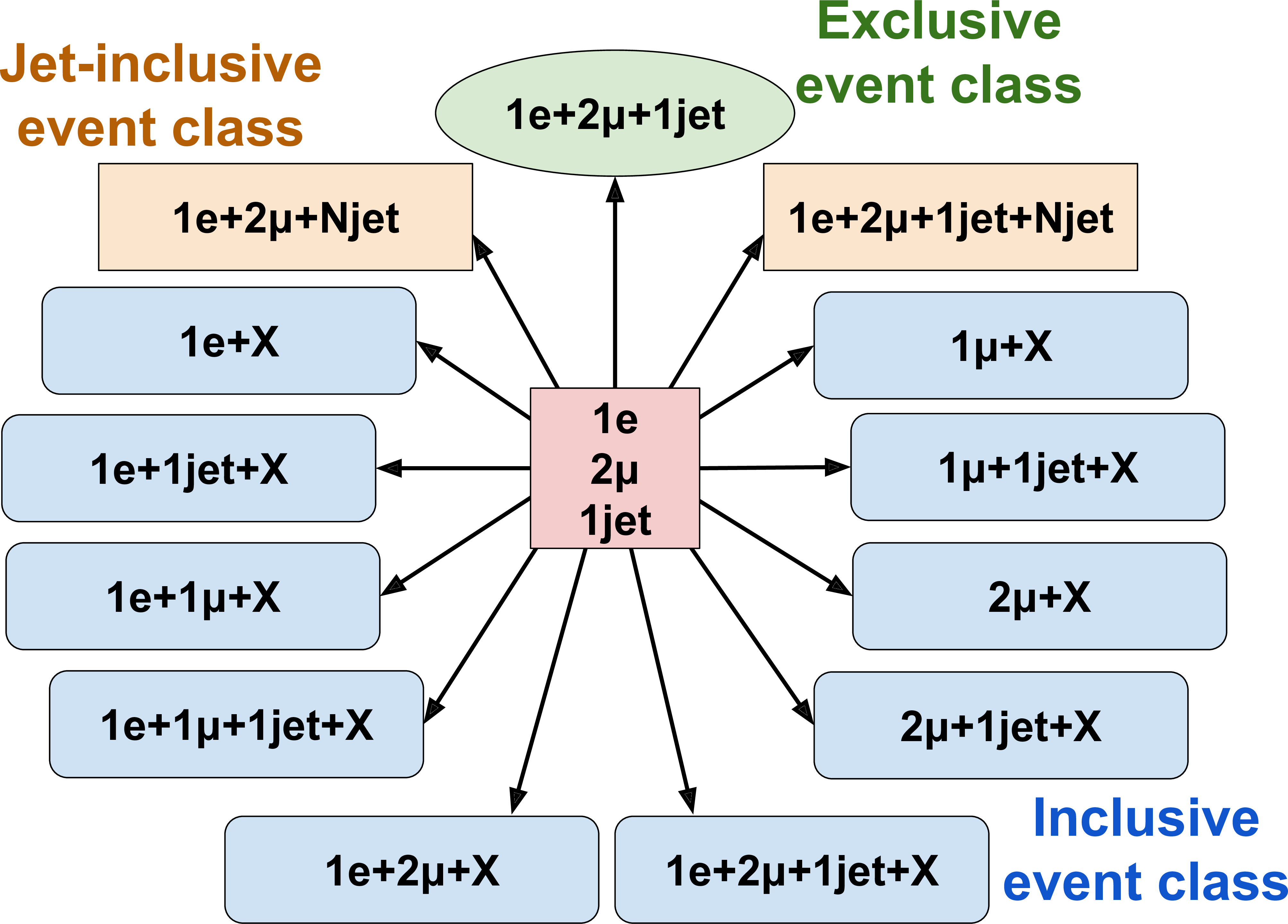
png pdf |
Figure 1:
Classification of a single event (red square) containing one electron, two muons, and one jet. This event will contribute to precisely one exclusive (green), and several inclusive (blue) and jet-inclusive (orange) event classes. |

png pdf |
Figure 2:
Illustration for the calculation of $p$-values in different regions and the selection of the region of interest as the region with the smallest $p$-value. |

png pdf |
Figure 3:
Illustrative example of a $\tilde{p}$-value distribution for different event classes (final states) based on an ${S_{\mathrm {T}}}$ distribution RoI scan. Histograms of the number of event classes corresponding to a bin in $-\log_{10}(\tilde{p})$ for the different pseudo experiment rounds (shown on the left) are used to create the global overview plot for a scan of each particular kinematic distribution for each event class type (shown on the right for ${S_{\mathrm {T}}}$ distribution scan in exclusive event classes, without showing the observed deviations from data here). The mean and the median distributions of $\tilde{p}$-values obtained from the different pseudo experiments are shown as solid cyan and dashed grey lines. The distribution estimated from the analytic calculation is shown as green dashed line. The 68% ($ \pm $1$ \sigma $) and 95% ($ \pm $2$ \sigma $) uncertainty bands are displayed as dark blue and light blue areas respectively. |

png pdf |
Figure 4:
Distribution of transverse mass for the 1$\mu$ + ${{p_{\mathrm {T}}} ^\text {miss}} $ exclusive class with a hypothetical SSM W' boson (with mass of 3 TeV) signal shown on top of the SM simulation. |

png pdf |
Figure 5-a:
Distribution of $\tilde{p}$-values for the region of interest scan in exclusive classes for the invariant mass (transverse mass for classes with ${{p_{\mathrm {T}}} ^\text {miss}}$) with assumed values for the mass of the SSM W' boson of 2 TeV (top), 3 TeV (bottom left), and 4 TeV (bottom right). The uncertainty in the distribution of $\tilde{p}$-values for the signal is obtained from the variations in the pseudo data performed with the W' signal simulation. |
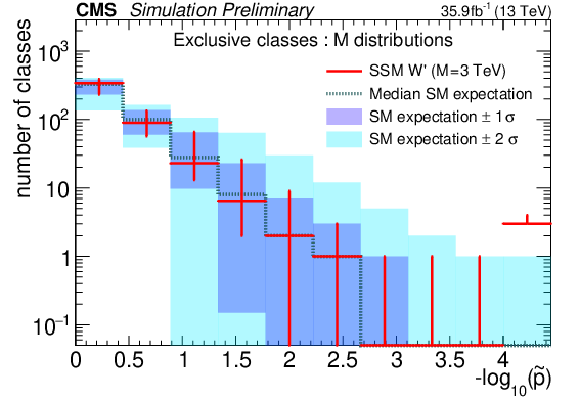
png pdf |
Figure 5-b:
Distribution of $\tilde{p}$-values for the region of interest scan in exclusive classes for the invariant mass (transverse mass for classes with ${{p_{\mathrm {T}}} ^\text {miss}}$) with assumed values for the mass of the SSM W' boson of 2 TeV (top), 3 TeV (bottom left), and 4 TeV (bottom right). The uncertainty in the distribution of $\tilde{p}$-values for the signal is obtained from the variations in the pseudo data performed with the W' signal simulation. |
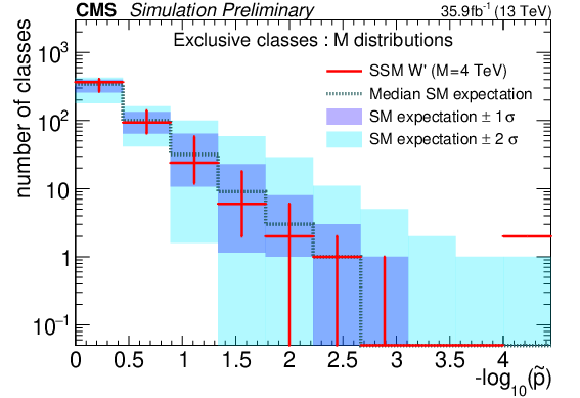
png pdf |
Figure 5-c:
Distribution of $\tilde{p}$-values for the region of interest scan in exclusive classes for the invariant mass (transverse mass for classes with ${{p_{\mathrm {T}}} ^\text {miss}}$) with assumed values for the mass of the SSM W' boson of 2 TeV (top), 3 TeV (bottom left), and 4 TeV (bottom right). The uncertainty in the distribution of $\tilde{p}$-values for the signal is obtained from the variations in the pseudo data performed with the W' signal simulation. |

png pdf |
Figure 6:
Distribution of $\tilde{p}$-values for the region of interest scan in inclusive classes for the ${S_{\mathrm {T}}}$ distributions for a sphaleron signal with $E_{\text {sph}} = $ 8 TeV and PEF = 0.05. The uncertainty in the distribution of $\tilde{p}$-values for the signal is obtained from the variations in the pseudo data performed with the sphaleron signal simulation. |
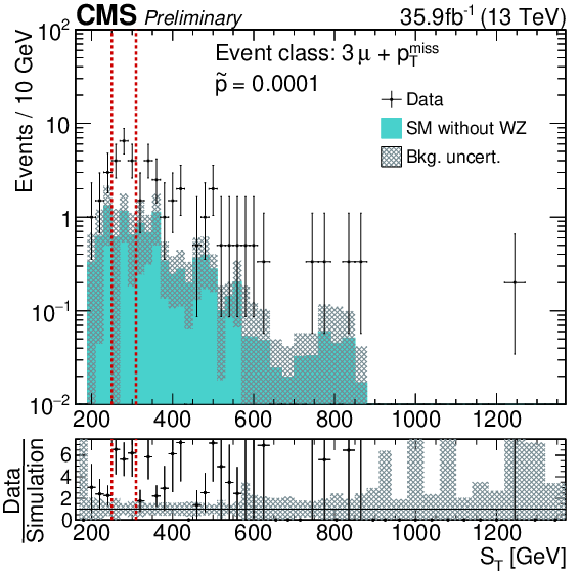
png pdf |
Figure 7-a:
Distributions of ${S_{\mathrm {T}}}$ for the 3$\mu$ + $ {{p_{\mathrm {T}}} ^\text {miss}} $ exclusive class without (left) and with (right) WZ production as part of the SM simulation. The data events are shown in black and the MC simulations of the SM processes are shown as colored histograms. The region enclosed within the red dashed lines is the region of interest. |

png pdf |
Figure 7-b:
Distributions of ${S_{\mathrm {T}}}$ for the 3$\mu$ + $ {{p_{\mathrm {T}}} ^\text {miss}} $ exclusive class without (left) and with (right) WZ production as part of the SM simulation. The data events are shown in black and the MC simulations of the SM processes are shown as colored histograms. The region enclosed within the red dashed lines is the region of interest. |

png pdf |
Figure 8:
Most significant exclusive event classes, where the significance of an event class is calculated in a single aggregated bin. The values at the top indicate the observed $p$-value for each event class. |

png pdf |
Figure 9-a:
Overview of total contributions (single bin) for the double electron object group (top) and for the single muon + ${{p_{\mathrm {T}}} ^\text {miss}}$ object group (bottom). The numbers on the top of each bin indicate the observed $p$-value for the agreement of data and simulation for the corresponding event class. |
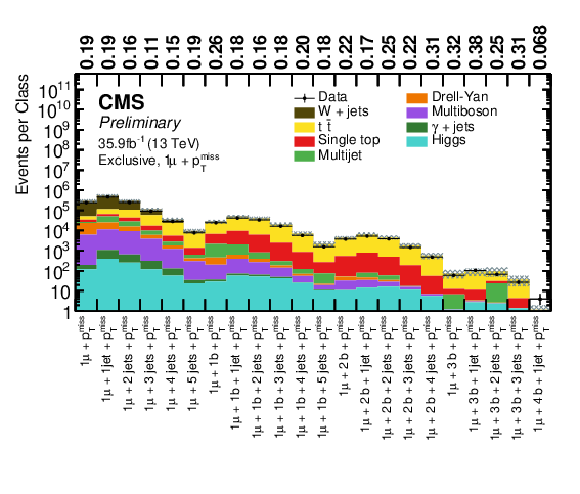
png pdf |
Figure 9-b:
Overview of total contributions (single bin) for the double electron object group (top) and for the single muon + ${{p_{\mathrm {T}}} ^\text {miss}}$ object group (bottom). The numbers on the top of each bin indicate the observed $p$-value for the agreement of data and simulation for the corresponding event class. |

png pdf |
Figure 10-a:
An example ${S_{\mathrm {T}}}$ distribution for the 2$\mu$ exclusive event class (top left), distribution of ${M}$ for the 2$\mu$ exclusive event class (top right), and the ${{p_{\mathrm {T}}} ^\text {miss}}$ distribution for the 2$\mu$ + ${{p_{\mathrm {T}}} ^\text {miss}}$ + X inclusive event class (bottom). Measured data are shown as black markers, contributions from SM processes are represented by colored bars, and the regions enclosed by red dashed lines correspond to the regions of interest. |

png pdf |
Figure 10-b:
An example ${S_{\mathrm {T}}}$ distribution for the 2$\mu$ exclusive event class (top left), distribution of ${M}$ for the 2$\mu$ exclusive event class (top right), and the ${{p_{\mathrm {T}}} ^\text {miss}}$ distribution for the 2$\mu$ + ${{p_{\mathrm {T}}} ^\text {miss}}$ + X inclusive event class (bottom). Measured data are shown as black markers, contributions from SM processes are represented by colored bars, and the regions enclosed by red dashed lines correspond to the regions of interest. |

png pdf |
Figure 10-c:
An example ${S_{\mathrm {T}}}$ distribution for the 2$\mu$ exclusive event class (top left), distribution of ${M}$ for the 2$\mu$ exclusive event class (top right), and the ${{p_{\mathrm {T}}} ^\text {miss}}$ distribution for the 2$\mu$ + ${{p_{\mathrm {T}}} ^\text {miss}}$ + X inclusive event class (bottom). Measured data are shown as black markers, contributions from SM processes are represented by colored bars, and the regions enclosed by red dashed lines correspond to the regions of interest. |

png pdf |
Figure 11-a:
Distribution of $\tilde{p}$-values for the region of interest scan in exclusive classes for the ${M}$ (top), ${S_{\mathrm {T}}}$ (middle), and ${{p_{\mathrm {T}}} ^\text {miss}}$ (bottom) distributions. |

png pdf |
Figure 11-b:
Distribution of $\tilde{p}$-values for the region of interest scan in exclusive classes for the ${M}$ (top), ${S_{\mathrm {T}}}$ (middle), and ${{p_{\mathrm {T}}} ^\text {miss}}$ (bottom) distributions. |

png pdf |
Figure 11-c:
Distribution of $\tilde{p}$-values for the region of interest scan in exclusive classes for the ${M}$ (top), ${S_{\mathrm {T}}}$ (middle), and ${{p_{\mathrm {T}}} ^\text {miss}}$ (bottom) distributions. |
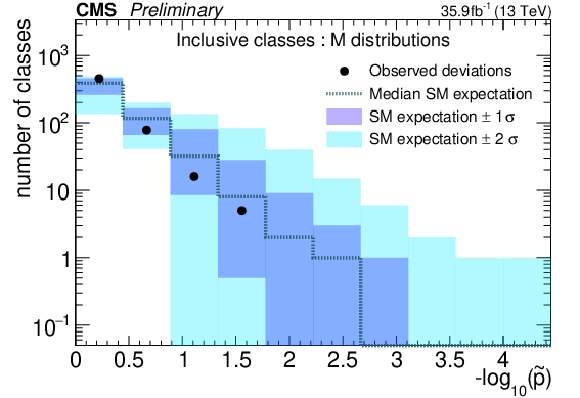
png pdf |
Figure 12-a:
Distribution of $\tilde{p}$-values for the region of interest scan in inclusive classes for the ${M}$ (top), ${S_{\mathrm {T}}}$ (middle), and ${{p_{\mathrm {T}}} ^\text {miss}}$ (bottom) distributions. |

png pdf |
Figure 12-b:
Distribution of $\tilde{p}$-values for the region of interest scan in inclusive classes for the ${M}$ (top), ${S_{\mathrm {T}}}$ (middle), and ${{p_{\mathrm {T}}} ^\text {miss}}$ (bottom) distributions. |
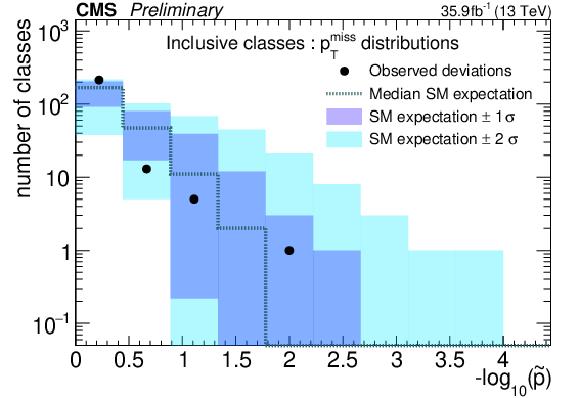
png pdf |
Figure 12-c:
Distribution of $\tilde{p}$-values for the region of interest scan in inclusive classes for the ${M}$ (top), ${S_{\mathrm {T}}}$ (middle), and ${{p_{\mathrm {T}}} ^\text {miss}}$ (bottom) distributions. |
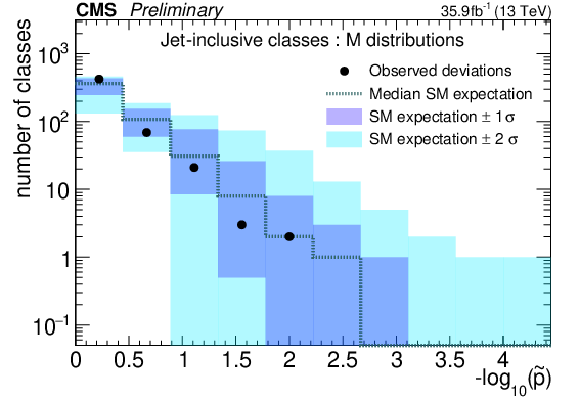
png pdf |
Figure 13-a:
Distribution of $\tilde{p}$-values for the region of interest scan in jet-inclusive classes for the ${M}$ (top), ${S_{\mathrm {T}}}$ (middle), and ${{p_{\mathrm {T}}} ^\text {miss}}$ (bottom) distributions. |
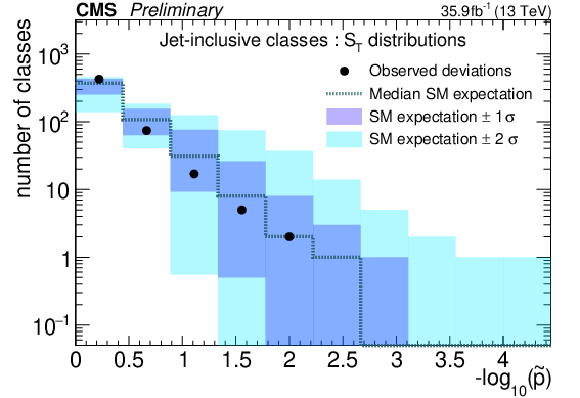
png pdf |
Figure 13-b:
Distribution of $\tilde{p}$-values for the region of interest scan in jet-inclusive classes for the ${M}$ (top), ${S_{\mathrm {T}}}$ (middle), and ${{p_{\mathrm {T}}} ^\text {miss}}$ (bottom) distributions. |

png pdf |
Figure 13-c:
Distribution of $\tilde{p}$-values for the region of interest scan in jet-inclusive classes for the ${M}$ (top), ${S_{\mathrm {T}}}$ (middle), and ${{p_{\mathrm {T}}} ^\text {miss}}$ (bottom) distributions. |

png pdf |
Figure 14:
Overview of total event yields for the event classes for the single muon object group. The numbers on the top indicate the observed $p$-value for the agreement of data and simulation. |

png pdf |
Figure 15:
Overview of total event yields for the event classes for the single electron object group. The numbers on the top indicate the observed $p$-value for the agreement of data and simulation. |
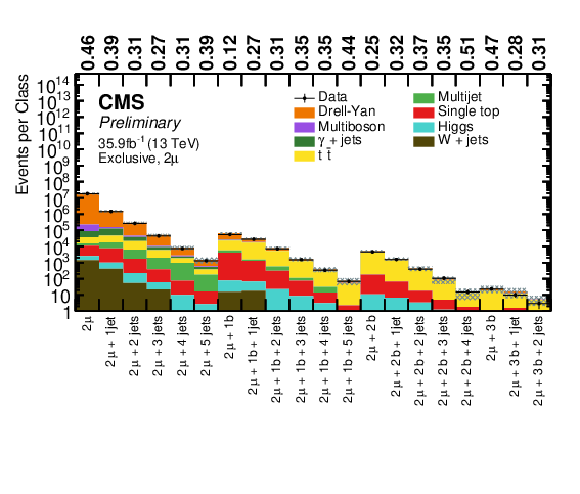
png pdf |
Figure 16:
Overview of total event yields for the event classes for the double muon object group. The numbers on the top indicate the observed $p$-value for the agreement of data and simulation. |

png pdf |
Figure 17:
Overview of total event yields for the event classes for the muon + electron object group. The numbers on the top indicate the observed $p$-value for the agreement of data and simulation. |

png pdf |
Figure 18:
Overview of total event yields for the event classes for the single electron + ${{p_{\mathrm {T}}} ^\text {miss}}$ object group. The numbers on the top indicate the observed $p$-value for the agreement of data and simulation. |
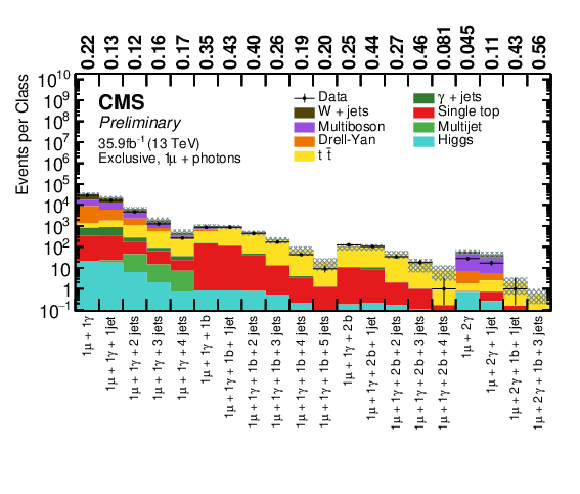
png pdf |
Figure 19:
Overview of total event yields for the event classes for the single muon + photons object group. The numbers on the top indicate the observed $p$-value for the agreement of data and simulation. |
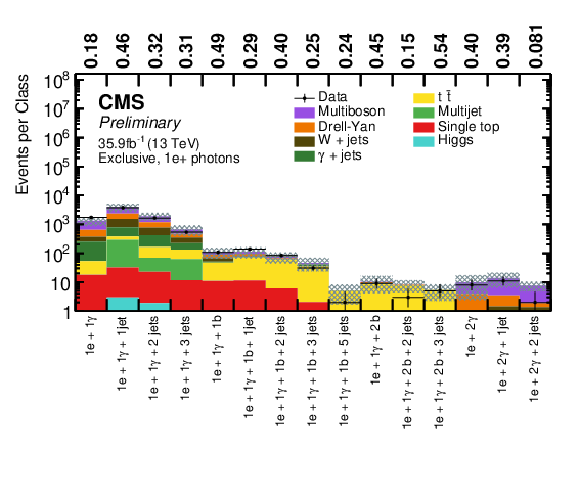
png pdf |
Figure 20:
Overview of total event yields for the event classes for the single electron + photons object group. The numbers on the top indicate the observed $p$-value for the agreement of data and simulation. |
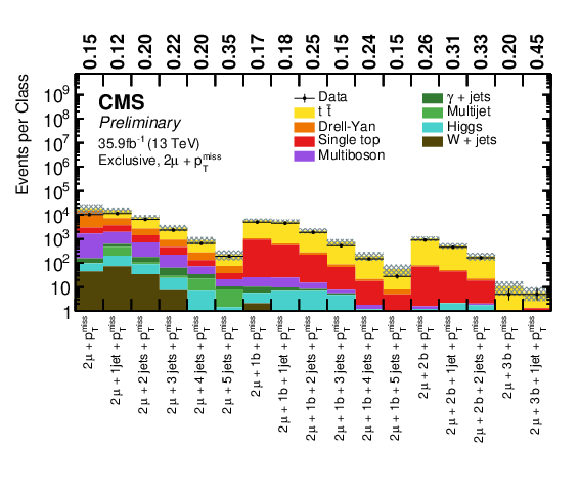
png pdf |
Figure 21:
Overview of total event yields for the event classes for the double muon + ${{p_{\mathrm {T}}} ^\text {miss}}$ object group. The numbers on the top indicate the observed $p$-value for the agreement of data and simulation. |
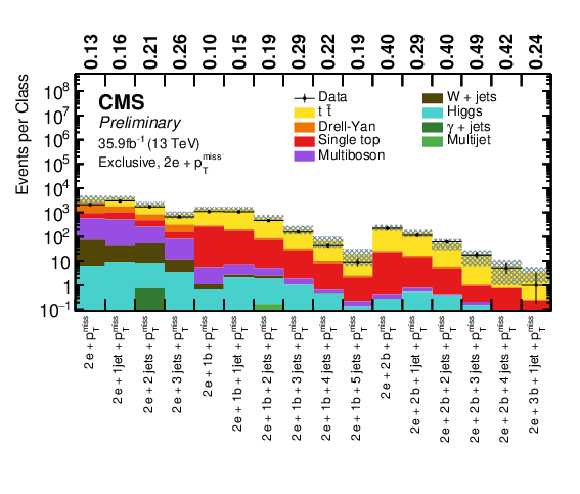
png pdf |
Figure 22:
Overview of total event yields for the event classes for the double electron + ${{p_{\mathrm {T}}} ^\text {miss}}$ object group. The numbers on the top indicate the observed $p$-value for the agreement of data and simulation. |
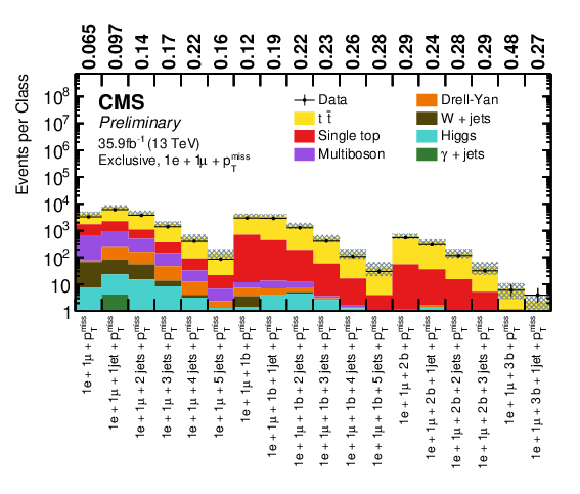
png pdf |
Figure 23:
Overview of total event yields for the event classes for the single electron + single muon + ${{p_{\mathrm {T}}} ^\text {miss}}$ object group. The numbers on the top indicate the observed $p$-value for the agreement of data and simulation. |

png pdf |
Figure 24:
Overview of total event yields for the event classes for the single muon + photons + ${{p_{\mathrm {T}}} ^\text {miss}}$ object group. The numbers on the top indicate the observed $p$-value for the agreement of data and simulation. |
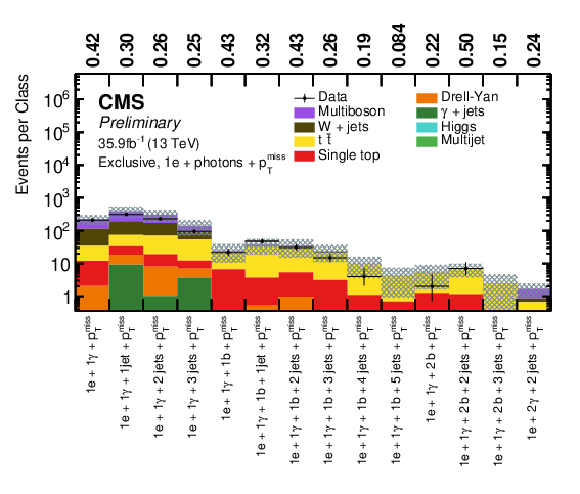
png pdf |
Figure 25:
Overview of total event yields for the event classes for the single electron + photons + ${{p_{\mathrm {T}}} ^\text {miss}}$ object group. The numbers on the top indicate the observed $p$-value for the agreement of data and simulation. |
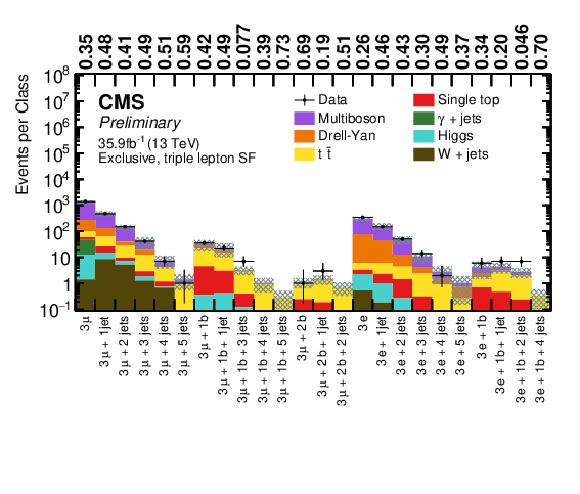
png pdf |
Figure 26:
Overview of total event yields for the event classes for the three lepton (same flavor) object group. The numbers on the top indicate the observed $p$-value for the agreement of data and simulation. |
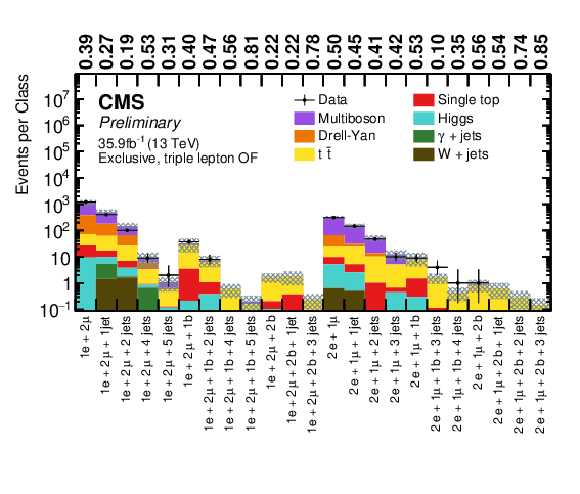
png pdf |
Figure 27:
Overview of total event yields for the event classes for the three lepton (different flavor) object group. The numbers on the top indicate the observed $p$-value for the agreement of data and simulation. |
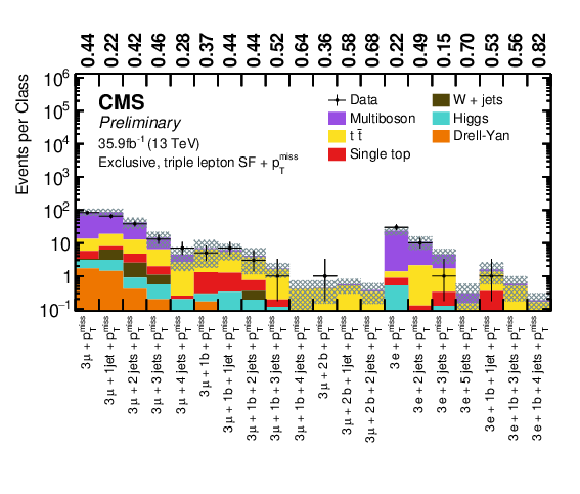
png pdf |
Figure 28:
Overview of total event yields for the event classes for the three lepton (same flavor) + ${{p_{\mathrm {T}}} ^\text {miss}}$ object group. The numbers on the top indicate the observed $p$-value for the agreement of data and simulation. |
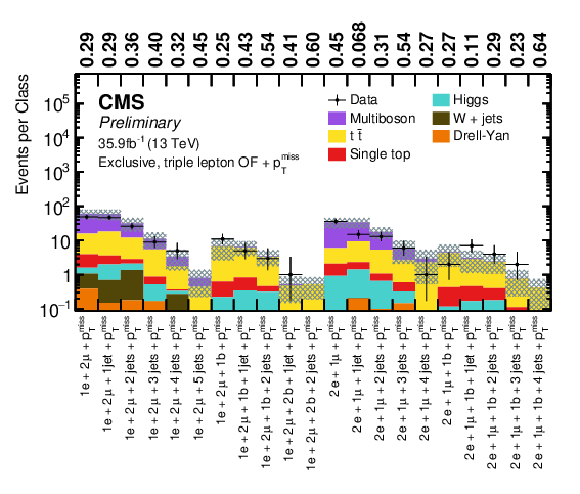
png pdf |
Figure 29:
Overview of total event yields for the event classes for the three lepton (different flavor)+ ${{p_{\mathrm {T}}} ^\text {miss}}$ object group. The numbers on the top indicate the observed $p$-value for the agreement of data and simulation. |
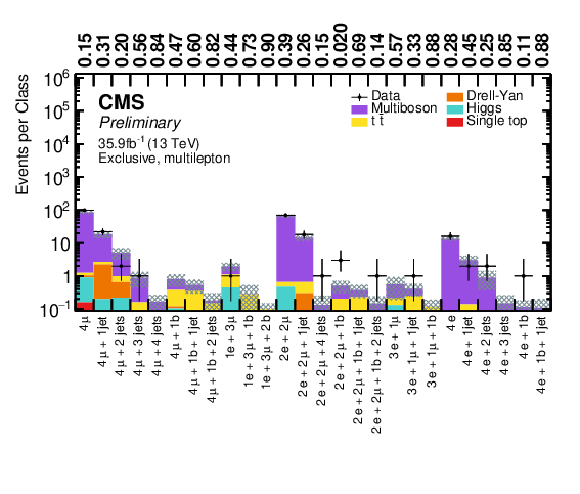
png pdf |
Figure 30:
Overview of total event yields for the event classes for the multilepton (four or more leptons) object group. The numbers on the top indicate the observed $p$-value for the agreement of data and simulation. |
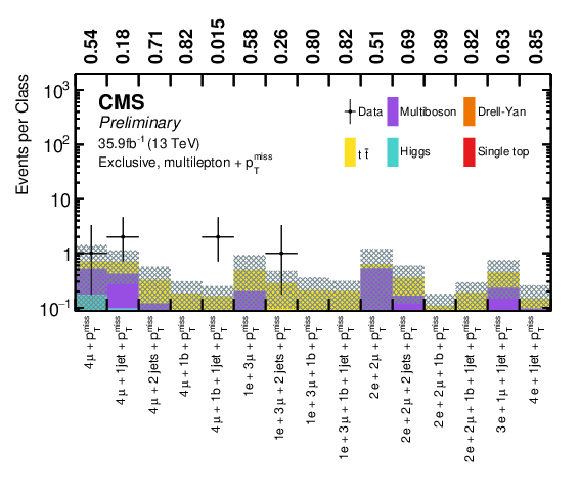
png pdf |
Figure 31:
Overview of total event yields for the event classes for the multilepton (four or more leptons) + ${{p_{\mathrm {T}}} ^\text {miss}}$ object group. The numbers on the top indicate the observed $p$-value for the agreement of data and simulation. |
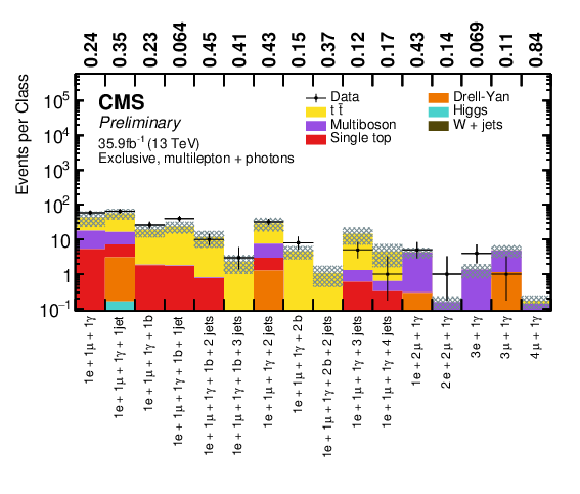
png pdf |
Figure 32:
Overview of total event yields for the event classes for the multilepton (more than one lepton) + photons object group. The numbers on the top indicate the observed $p$-value for the agreement of data and simulation. |
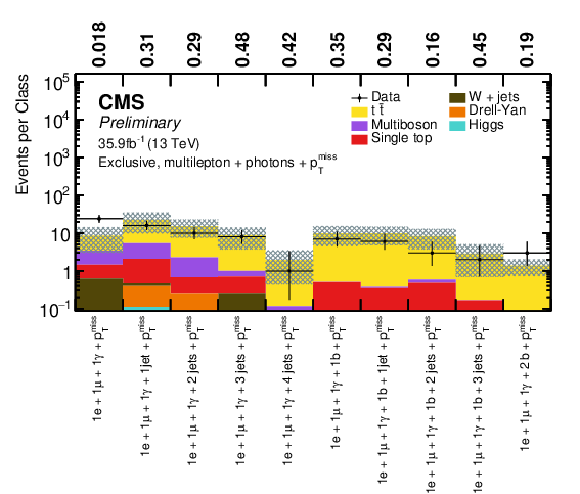
png pdf |
Figure 33:
Overview of total event yields for the event classes for the multilepton (more than one lepton) + photons + ${{p_{\mathrm {T}}} ^\text {miss}}$ object group. The numbers on the top indicate the observed $p$-value for the agreement of data and simulation. |
| Tables | |

png pdf |
Table 1:
Summary of simulated samples used. |

png pdf |
Table 2:
Summary of object selection criteria. |

png pdf |
Table 3:
Summary of online and offline trigger criteria. |

png pdf |
Table 4:
Summary of systematic uncertainties in the analysis. |

png pdf |
Table 5:
Overview of the two most significant event classes in each RoI scan. Details of the region of interest, the simulated expectation and the number of data events within the region of interest are shown along with the $p$- and $\tilde{p}$-values. |
| Summary |
|
The Model Unspecific Search in CMS (MUSiC) analysis, using data recorded by the CMS detector at the LHC during proton-proton collisions at a center of mass energy of $\sqrt{s} = $ 13 TeV in 2016 and corresponding to an integrated luminosity of 35.9 fb$^{-1}$ , has been presented. The MUSiC analysis searches for anomalies and possible hints of physics beyond the standard model in the data using a model-independent approach, relying solely on the assumptions of the well-tested standard model. Events from data and simulation have been sorted into event classes based on their final state topology, taking electrons, muons, photons, jets, b-tagged jets, and missing transverse momentum into account. The event yields were compared between the data and the expectation in a wide range of event classes. The kinematic distributions corresponding to the sum of transverse momenta, invariant mass (or transverse mass), and missing transverse momentum in each of the event classes have been scanned using a region of interest algorithm. The algorithm identifies deviations of the data from the simulation-based prediction for the standard model, calculating a $\tilde{p}$-value of any observed deviation after correcting for the look elsewhere effect. A global overview of the results from the different event classes and distributions has been presented. The sensitivity and robustness of the analysis have been demonstrated in multiple studies. No significant deviations beyond expectations were found in the analyzed data by the MUSiC algorithm. A wide range of final state topologies have been studied, and agreement has been found between the data and the standard model simulation given the experimental and theoretical uncertainties. |
| Additional Figures | |

png pdf |
Additional Figure 1:
Event display of an event with two muons, shown as the red lines, recorded by the CMS experiment in proton-proton collisions in 2016. This is an example of an event that enters the MUSiC analysis and is classified into the 2$\mu $ exclusive event class. In the event display, the yellow lines show the reconstructed tracks associated with charged particles with $p_{\mathrm{T}} > $ 2 GeV, the deposits in the CMS electromagnetic (hadronic) calorimeters are shown as the regions shaded in green (blue), the red lines show the tracks for muons with $p_{\mathrm{T}} > $ 20 GeV and the red shaded regions represent the parts the of CMS muon detector system with hits associated with the muon tracks. |

png pdf |
Additional Figure 2:
Event display of an event with two muons, shown as the red lines, recorded by the CMS experiment in proton-proton collisions in 2016. This is an example of an event that enters the MUSiC analysis and is classified into the 2$\mu $ exclusive event class. This event display presents the r-z view of the CMS detector. In the event display, the yellow lines show the reconstructed tracks associated with charged particles with $p_{\mathrm{T}} > $ 2 GeV, the deposits in the CMS electromagnetic (hadronic) calorimeters are shown as the regions shaded in green (blue), the red lines show the tracks for muons with $p_{\mathrm{T}} > $ 20 GeV and the red shaded regions represent the parts the of CMS muon detector system with hits associated with the muon tracks. |

png pdf |
Additional Figure 3:
Event display of an event with two muons, shown as the red lines, recorded by the CMS experiment in proton-proton collisions in 2016. This is an example of an event that enters the MUSiC analysis and is classified into the 2$\mu $ exclusive event class. This event display presents the $r-\phi $ view of the CMS detector. In the event display, the yellow lines show the reconstructed tracks associated with charged particles with $p_{\mathrm{T}} > $ 2 GeV, the deposits in the CMS electromagnetic (hadronic) calorimeters are shown as the regions shaded in green (blue), the red lines show the tracks for muons with $p_{\mathrm{T}} > $ 20 GeV and the red shaded regions represent the parts the of CMS muon detector system with hits associated with the muon tracks. |
| References | ||||
| 1 | CMS Collaboration | The CMS experiment at the CERN LHC | JINST 3 (2008) S08004 | CMS-00-001 |
| 2 | D0 Collaboration | Search for new physics in $ e {\mu}X $ data at D0 using SLEUTH: A quasi-model-independent search strategy for new physics | PRD 62 (2000) 092004 | hep-ex/0006011 |
| 3 | D0 Collaboration | Quasi-model-independent search for new physics at large transverse momentum | PRD 64 (2001) 012004 | hep-ex/0011067 |
| 4 | D0 Collaboration | Quasi-model-independent search for new high $ {p}_{T} $ physics at D0 | PRL 86 (2001) 3712 | hep-ex/0011071 |
| 5 | CDF Collaboration | Model-independent and quasi-model-independent search for new physics at CDF | PRD 78 (2008) 012002 | 0712.1311 |
| 6 | CDF Collaboration | Global search for new physics with 2.0 fb$ ^{-1} $ at CDF | PRD 79 (2009) 011101 | 0809.3781 |
| 7 | H1 Collaboration | A general search for new phenomena in ep scattering at HERA | Physics Letters B 602 (2004) 14 | hep-ex/0408044 |
| 8 | H1 Collaboration | A general search for new phenomena at HERA | PLB 674 (2009) 257 | 0901.0507 |
| 9 | ATLAS Collaboration | A strategy for a general search for new phenomena using data-derived signal regions and its application within the ATLAS experiment | EPJC 79 (2019) 120 | 1807.07447 |
| 10 | CMS Collaboration | Model unspecific search for new physics in pp collisions at $ \sqrt{s}=7 \mathrm{TeV} $ | CMS-PAS-EXO-10-021 | |
| 11 | CMS Collaboration | MUSiC, a model unspecific search for new physics, in pp collisions at $ \sqrt{s}=8 \mathrm{TeV} $ | CMS-PAS-EXO-14-016 | CMS-PAS-EXO-14-016 |
| 12 | CMS Collaboration | The CMS trigger system | JINST 12 (2017) P01020 | CMS-TRG-12-001 1609.02366 |
| 13 | CMS Collaboration | Particle-flow reconstruction and global event description with the CMS detector | JINST 12 (2017) P10003 | CMS-PRF-14-001 1706.04965 |
| 14 | CMS Collaboration | Performance of photon reconstruction and identification with the CMS detector in proton-proton collisions at $ \sqrt{s} = $ 8 ~TeV | JINST 10 (2015) P08010 | CMS-EGM-14-001 1502.02702 |
| 15 | CMS Collaboration | Performance of electron reconstruction and selection with the CMS detector in proton-proton collisions at $ \sqrt{s} = $ 8 TeV | JINST 10 (2015) P06005 | CMS-EGM-13-001 1502.02701 |
| 16 | CMS Collaboration | Performance of the CMS muon detector and muon reconstruction with proton-proton collisions at $ \sqrt{s} = $ 13 TeV | JINST 13 (2018) P06015 | CMS-MUO-16-001 1804.04528 |
| 17 | M. Cacciari, G. P. Salam, and G. Soyez | The anti-$ k_t $ jet clustering algorithm | JHEP 04 (2008) 063 | 0802.1189 |
| 18 | M. Cacciari, G. P. Salam, and G. Soyez | FastJet user manual | EPJC 72 (2012) 1896 | 1111.6097 |
| 19 | CMS Collaboration | Jet energy scale and resolution in the CMS experiment in pp collisions at 8 TeV | JINST 12 (2017) P02014 | CMS-JME-13-004 1607.03663 |
| 20 | CMS Collaboration | Identification of heavy-flavour jets with the CMS detector in pp collisions at 13 TeV | JINST 13 (2018) P05011 | CMS-BTV-16-002 1712.07158 |
| 21 | CMS Collaboration | Performance of missing transverse momentum reconstruction in proton-proton collisions at $ \sqrt{s}= $ 13 TeV using the CMS detector | JINST 14 (2019) P07004 | CMS-JME-17-001 1903.06078 |
| 22 | T. Sjostrand et al. | An introduction to PYTHIA 8.2 | CPC 191 (2015) 159 | 1410.3012 |
| 23 | J. Alwall et al. | The automated computation of tree-level and next-to-leading order differential cross sections, and their matching to parton shower simulations | JHEP 07 (2014) 079 | 1405.0301 |
| 24 | J. Alwall et al. | Comparative study of various algorithms for the merging of parton showers and matrix elements in hadronic collisions | EPJC 53 (2008) 473 | 0706.2569 |
| 25 | R. Frederix and S. Frixione | Merging meets matching in MC@NLO | JHEP 12 (2012) 061 | 1209.6215 |
| 26 | P. Nason | A new method for combining NLO QCD with shower Monte Carlo algorithms | JHEP 11 (2004) 040 | hep-ph/0409146 |
| 27 | S. Frixione, P. Nason, and C. Oleari | Matching NLO QCD computations with parton shower simulations: the $ \sc $ powheg method | JHEP 11 (2007) 070 | 0709.2092 |
| 28 | S. Alioli, P. Nason, C. Oleari, and E. Re | A general framework for implementing NLO calculations in shower Monte Carlo programs: the POWHEG BOX | JHEP 06 (2010) 043 | 1002.2581 |
| 29 | S. Alioli, P. Nason, C. Oleari, and E. Re | NLO vector-boson production matched with shower in POWHEG | JHEP 07 (2008) 060 | 0805.4802 |
| 30 | E. Re | Single-top Wt-channel production matched with parton showers using the POWHEG method | EPJC 71 (2011) 1547 | 1009.2450 |
| 31 | S. Alioli, P. Nason, C. Oleari, and E. Re | NLO single-top production matched with shower in POWHEG: s- and t-channel contributions | JHEP 09 (2009) 111 | 0907.4076 |
| 32 | S. Alioli, P. Nason, C. Oleari, and E. Re | NLO Higgs boson production via gluon fusion matched with shower in POWHEG | JHEP 04 (2009) 002 | 0812.0578 |
| 33 | P. Nason and C. Oleari | NLO Higgs boson production via vector-boson fusion matched with shower in POWHEG | JHEP 02 (2010) 037 | 0911.5299 |
| 34 | T. Melia, P. Nason, R. Rontsch, and G. Zanderighi | W$ ^+ $W$ ^- $, WZ and ZZ production in the POWHEG BOX | JHEP 11 (2011) 078 | 1107.5051 |
| 35 | P. Nason and G. Zanderighi | W$ ^+ $W$ ^- $, WZ and ZZ production in the POWHEG-BOX-V2 | EPJC 74 (2014) 2702 | 1311.1365 |
| 36 | J. M. Campbell, R. K. Ellis, P. Nason, and E. Re | Top-pair production and decay at NLO matched with parton showers | JHEP 04 (2015) 114 | 1412.1828 |
| 37 | E. Bagnaschi, G. Degrassi, P. Slavich, and A. Vicini | Higgs production via gluon fusion in the POWHEG approach in the SM and in the MSSM | JHEP 02 (2012) 088 | 1111.2854 |
| 38 | Sherpa Collaboration | Event generation with Sherpa 2.2 | SciPost Phys. 7 (2019) 034 | 1905.09127 |
| 39 | T. Gleisberg et al. | Event generation with SHERPA 1.1 | JHEP 02 (2009) 007 | 0811.4622 |
| 40 | NNPDF Collaboration | Parton distributions for the LHC Run II | JHEP 04 (2015) 040 | 1410.8849 |
| 41 | CMS Collaboration | Event generator tunes obtained from underlying event and multiparton scattering measurements | EPJC 76 (2016) 155 | CMS-GEN-14-001 1512.00815 |
| 42 | GEANT4 Collaboration | GEANT4: A simulation toolkit | NIMA 506 (2003) 250 | |
| 43 | R. Gavin, Y. Li, F. Petriello, and S. Quackenbush | FEWZ 2.0: A code for hadronic Z production at next-to-next-to-leading order | Computer Physics Communications 182 (2011) 2388 | 1011.3540 |
| 44 | S. G. Bondarenko and A. A. Sapronov | NLO EW and QCD proton-proton cross section calculations with mcsanc-v1.01 | CPC 184 (2013) 2343 | 1301.3687 |
| 45 | J. M. Campbell and R. K. Ellis | MCFM for the Tevatron and the LHC | NPPS 205--206 (2010) 10 | 1007.3492 |
| 46 | T. Gehrmann et al. | W$ ^+ $W$ ^- $ production at hadron colliders in next to next to leading order QCD | PRL 113 (2014) 212001 | 1408.5243 |
| 47 | M. Czakon and A. Mitov | Top++: A program for the calculation of the top-pair cross-section at hadron colliders | CPC 185 (2014) 2930 | 1112.5675 |
| 48 | M. Aliev et al. | HATHOR: HAdronic Top and Heavy quarks crOss section calculatoR | CPC 182 (2011) 1034 | 1007.1327 |
| 49 | P. Kant et al. | HATHOR for single top-quark production: Updated predictions and uncertainty estimates for single top-quark production in hadronic collisions | CPC 191 (2015) 74 | 1406.4403 |
| 50 | LHC Higgs Cross Section Working Group Collaboration | Handbook of LHC Higgs cross sections: 4. Deciphering the nature of the Higgs sector | 1610.07922 | |
| 51 | CMS Collaboration | Performance of the reconstruction and identification of high-momentum muons in proton-proton collisions at $ \sqrt{s} = $ 13 TeV | JINST 15 (2020) P02027 | CMS-MUO-17-001 1912.03516 |
| 52 | CMS Collaboration | Search for high-mass resonances in dilepton final states in proton-proton collisions at $ \sqrt{s}= $ 13 TeV | JHEP 06 (2018) 120 | CMS-EXO-16-047 1803.06292 |
| 53 | J. Butterworth et al. | PDF4LHC recommendations for LHC Run II | JPG 43 (2016) 023001 | 1510.03865 |
| 54 | CMS Collaboration | CMS luminosity measurements for the 2016 data taking period | CMS-PAS-LUM-17-001 | CMS-PAS-LUM-17-001 |
| 55 | G. Altarelli, B. Mele, and M. Ruiz-Altaba | Searching for new heavy vector bosons in $ p \bar{p} $ colliders | Z. Phys. C 45 (1989) 109, .[Erratum: Z. Phys.C47,676(1990)] | |
| 56 | CMS Collaboration | Search for high-mass resonances in final states with a lepton and missing transverse momentum at $ \sqrt{s}= $ 13 TeV | JHEP 06 (2018) 128 | CMS-EXO-16-033 1803.11133 |
| 57 | J. Ellis and K. Sakurai | Search for sphalerons in proton-proton collisions | JHEP 04 (2016) 086 | 1601.03654 |
| 58 | G. 't Hooft | Symmetry breaking through Bell-Jackiw anomalies | PRL 37 (1976) 8 | |
| 59 | F. R. Klinkhamer and N. S. Manton | A saddle-point solution in the Weinberg-Salam theory | PRD 30 (1984) 2212 | |
| 60 | A. Ringwald | High-energy breakdown of perturbation theory in the electroweak instanton sector | NPB 330 (1990) 1 | |
| 61 | M. Trodden | Electroweak baryogenesis | Rev. Mod. Phys. 71 (1999) 1463 | hep-ph/9803479 |
| 62 | CMS Collaboration | Search for black holes and sphalerons in high-multiplicity final states in proton-proton collisions at $ \sqrt{s}= $ 13 TeV | JHEP 11 (2018) 042 | CMS-EXO-17-023 1805.06013 |
| 63 | C. Bravo and J. Hauser | BaryoGEN, a Monte Carlo generator for sphaleron-like transitions in proton-proton collisions | JHEP 11 (2018) 041 | 1805.02786 |
| 64 | H.-L. Lai et al. | New parton distributions for collider physics | PRD 82 (2010) 074024 | 1007.2241 |
| 65 | CMS Collaboration | Search for Z$ \gamma $ resonances using leptonic and hadronic final states in proton-proton collisions at $ \sqrt{s}= $ 13 TeV | JHEP 09 (2018) 148 | CMS-EXO-17-005 1712.03143 |

|
Compact Muon Solenoid LHC, CERN |

|

|

|

|

|

|